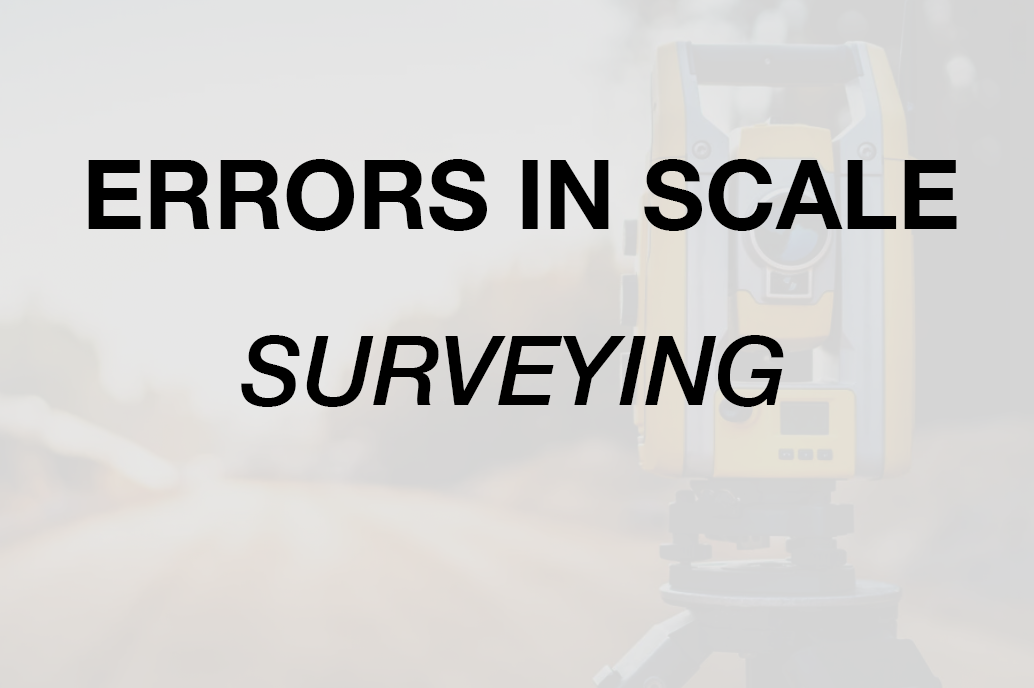ERRORS IN SCALE - SURVEYING (StudyCivilEngg.com)
ERRORS IN SCALE
SUBJECT : SURVEYING
ERRORS DUE TO SHRINKAGE OF MAP
The drawing paper generally shrinks due to variation in the atmospheric temperature, humidity, etc. Consequently all the lines marked on the map shrink to some extent. Thus the lengths measured from the map after shrinkage of map are not the correct distances. If a graphical scale had also been drawn on the map, the correct distances can be measured using that scale. In absence of a graphical scale, the correct distance can be determined as under.
Select any two points A and B on the map and measure the distance between them with a scale. Convert this distance to the corresponding distance in the field by using the engineer’s scale or R.F. mentioned on the map. Locate the same points on the ground and measure the actual distance between them. If the map has shrunk, the actual distance would be more than the corresponding measured distance from the map. The ratio of the shrunk length to the actual length is known as the shrinkage ratio or the shrinkage factor. It is always less than unity. Thus the shrunk scale is less than the original scale.
Shrunk scale = Original scale × shrinkage Factor …(1.1)
The scales should be expressed as a ratio. Alternatively,
Shrunk R.F. = Original R.F. × Shrinkage Factor …(1.2)
Thus,
Correct distance = Measured Distance/Shrinkage Factor …(1.3)
As the area is product of two distances (length and width), with the dimensions [L²],
Correct area = Measured area/(Shrinkage Factor)² …(1.4)
Illustrative Example 1
The plan of an area has shrunk such that a line originally 10 cm now measures 9.5 cm. If the original scale of the plan was 1 cm = 10 m (R.F. = 1: 1000), determine (i) the shrinkage factor, (ii) shrunk scale, (iii) correct distance corresponding to a measured distance of 98 m, (iv) correct area corresponding to a measured area of 10,000 m2.
Solution
Shrinkage factor = 9.5/10 = 0.95
Shrunk R.F. = 1/1000X(0.95) = 1/1053
Shrunk scale, 1 cm = 10.53 m
Correct distance = = 98/0.95 = 103.16 m
Correct area = 10000/(0.95)² = 11080.33 m²
Illustrative Example 2
A rectangular plot in plan is 10 cm × 30 cm, drawn to a scale of 1 cm = 100 m. If the same plot is redrawn on a toposheet to a scale of 1 cm = 1 km, what would be its area on the toposheet? Determine also R.F. in each case.
Solution
R.F. of the original plan = 1/10000 = 1/10⁴
Actual area in the field = (10 × 30)(10⁴)² cm²
R.F. of the toposheet map = 1/100,000 = 1/10⁵
Area on the toposheet map = (10 × 30)(10⁴)² / (10⁵)² = 3 cm²
ERRORS DUE TO WRONG MEASURING SCALE
If a wrong measuring scale is used to measure the length of a line already drawn on the plan, the measured length will not be correct. For example, if the plan has been drawn to a scale of 1: 200, and the length is measured with a scale of R.F. of 1: 250, the measured distance of 25 cm will be actually 20 cm on the plan.
Thus Correct length = R.F.of the wrong scale × measured length/R.F. of the correct scale …(1.5)
As the area is the product of two distances,
Correct area = [R.F. of the wrong scale/R.F. of the correct scale]² x measured area
Illustrative Example 3
(a) A surveyor measured the distance between two points marked on the plan drawn to a scale of 1 cm = 1 m (R.F. = 1: 100) and found it to be 50 m. Later he detected that he used a wrong scale of 1 cm = 50 cm (R.F. = 1: 50) for the measurement. Determine the correct length. (b) What would be the correct area if the measured area is 60 m²?
Solution
Correct length = [R.F. of the wrong scale/R.F. of the correct scale] x measured length
= (1/50) ×50/(1/100) = 100 m
Correct area = [(1/50)/(1/100)]²×60 = 240 m²





Post a Comment